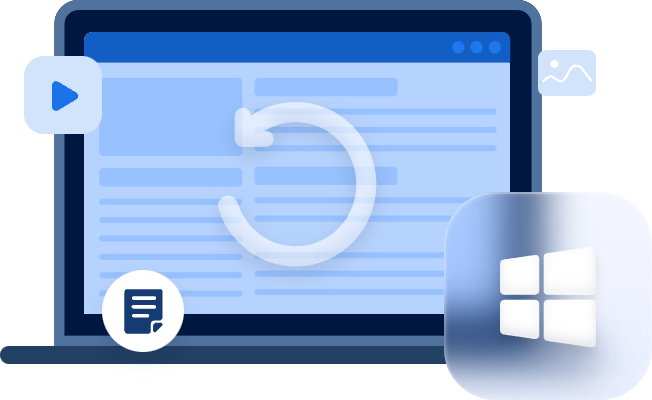I Accidentally Deleted My Windows Partition: How to Recover
What to do if I accidentally deleted my Windows partition? Don’t worry, this post provides you with a stepwise tutorial of how to recover deleted partition on your computer.
How do I restore a deleted Windows partition?
“I accidentally deleted my Windows partition during some maintenance activities on my computer. How do I recover a deleted partition in Windows 10?”
-Question from Microsoft Community
What to do if I accidentally deleted my Windows partition?
What will I do if I accidentally deleted my Windows partition? First, let’s make it clear, it is possible to recover a deleted Windows partition. But before ahead to the methods, you need to first figure out the type of the partition you have deleted, a disk partition or a boot partition. Because the methods for recovering deleted disk partition and accidentally deleted boot partition differ a lot.
Case A. How to restore Windows disk partition
If the Windows disk partition got deleted, the following 3 ways will help restore the deleted partition. Let’s see I accidentally deleted a partition how to recover.
Way 1. Recover the deleted partition via partition recovery software
To make things simpler, your best option is to choose a reputable partition recovery program. AOMEI Partition Recovery Wizard was specifically developed to restore lost or deleted partitions.
Step 1. Download, install, and run AOMEI Partition Assistant Professional. You could download the demo version below.
Step 2. Select Partition Recovery Wizard on the left panel in the main interface and select the disk including the lost partition. Click Next.
Step 3. Select a search mode. There are two kinds of search modes. It is recommended to choose Fast Search the first time. And then click Next.
Step 4. The tool will show the list of all lost or deleted partitions. You could select the partition you want to restore.
Step 5. After the partition recovery process completes, click Finish to exit when a message Congratulations shows. Then you can go to File Explorer to check the lost or deleted partitions.
Way 2. Restore lost partition with Disk Management
Sometimes, your partition may not be deleted, but missing from your computer for some reasons. If your partition is missing in File Explorer, you can use the embedded handy tool Disk Management.
Step 1. Start Control Panel, and click System and Security.
Step 2. Find Administrative tools, and click Create and format hard disk partitions, which lies on the lower part of this window.
Step 3. Right-click on the drive in which your deleted partition lies, and click Change Drive Letter and Paths.
Step 4. Go to Add to continue your operation.
Step 5. Check if Assign the following drive letter is successfully ticked, then assign a letter to name it, and commit your change by clicking OK. Here remember to assign a drive letter that has never been used before.
Way 3. Retrieve lost partition using CMD
If the missing partition is marked with an asterisk and hidden in Windows File Explorer, use CMD to assign it a drive letter and make it visible. Let's take a look at how to recover a lost partition with CMD.
Step 1. Open Disk Management and find the lost partition. Remember the partition size.
Step 2. Start Command Prompt by inputting cmd in the Windows search box > choose Run as administrator.
Step 3. Type the following command and press Enter after each input.
- diskpart
- list disk. All disks in the computer will be on the list.
- select disk # (Replace # with the number of the hard disk that contains the lost partition).
- list volume. All volumes on the disk will be displayed.
- select volume # (replace # with the number of the lost partition).
- assign letter=# (Replace # with an available drive letter, from C to Z).
Case B. How to restore Windows boot partition
If you delete the boot partition, the Windows PC will not boot. As a result, before recovering the deleted boot partition, you must first create bootable media with AOMEI Partition Assistant.
Notes:
- You'd better use a free USB flash drive because the data on the USB stick will be formatted.
- Prepare another bootable computer to make the bootable media.
Step 1. Install and launch AOMEI Partition Assistant on a working PC, then connect the USB stick to it. Click Make bootable media > Next.
Step 2. Select USB Boot Device, and click Proceed to begin the pending operation.
Step 3. Click the Yes button to make a bootable media.
Step 4. After creating the bootable media, plug the USB out of the bootable computer and plug it in the computert that can bot boot. Then you can restart the computer.
Step 5. Once you restart your computer, you can recover the deleted boot partition using the first way in Case A.
Closing words
What should I do if I accidentally deleted my Windows partition? There are two instances. If you've accidentally deleted a disk partition, you can recover it with AOMEI Partition Assistant, Disk Management, or CMD. If you have inadvertently deleted the boot partition, you must first create bootable media with AOMEI Partition Assistant before recovering the deleted partition.
You may also lose data if a partition is formatted or corrupted. At this time, it is recommended that you use MyRecover, a professional data recovery freeware, to easily recover your data.


